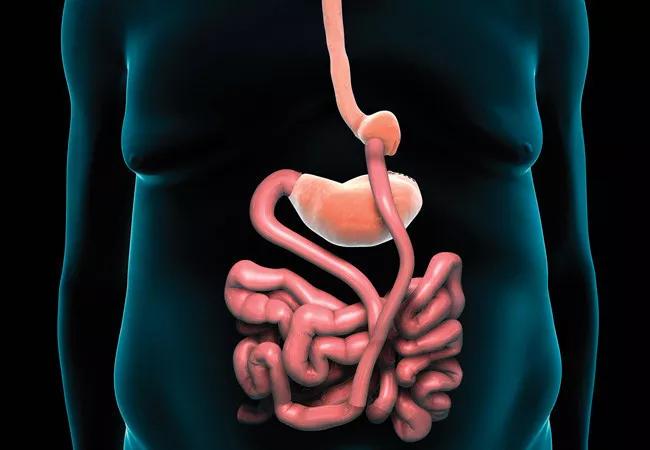Research suggests T2D variants with differing metabolic responses to gastric bypass

Type 2 diabetes (T2D) patients with co-morbid fatty liver disease who undergo gastric bypass surgery (GBP) are more likely to experience long-term diabetes remission than are T2D patients without fatty liver, according to a large retrospective analysis by Cleveland Clinic researchers.
Advertisement
Cleveland Clinic is a non-profit academic medical center. Advertising on our site helps support our mission. We do not endorse non-Cleveland Clinic products or services. Policy
The study’s findings — the first demonstration of a predictive association between liver steatosis and increased post-GBP diabetes remission — were presented at the Obesity Week 2019 international conference.
The results also indicate there may be T2D variants with differing metabolic responses to surgical weight loss.
“Our main goal was to examine whether fatty liver disease can serve as a predictor of diabetes remission after GBP in patients with T2D,” says Digestive Disease & Surgery Institute bariatric surgeon Ali Aminian, MD, the study’s lead author. “Previous research has shown that in approximately 50% of patients, diabetes goes to long-term remission after GBP, and we wanted to examine whether the presence of fatty liver disease contributes to these outcomes.”
Several clinical predictors of diabetes outcomes after GBP, such as diabetes duration and use of multiple medications, have already been established, but the role of fatty liver disease in T2D remained unclear until now, even though the two conditions are common comorbidities.
“About 70% of diabetic patients have some degree of fatty liver disease,” says Dr. Aminian. “Bariatric surgery is indicated in patients with severe obesity (BMI>35), or those with milder forms of obesity (BMI 30-35) and uncontrolled diabetes.”
The investigators hypothesized that patients with T2D who had fatty liver disease might benefit more from GBP: Improvement of their liver steatosis would contribute to improved glycemic control.
A total of 526 patients with T2D who underwent GBP and simultaneous liver biopsy at Cleveland Clinic from 2004 to 2012 were included in the study. Only those patients who were followed for a minimum of 5 years were eligible to participate. Diabetes remission was based on the American Diabetes Association criteria and defined as HbA1c<6.5% in the absence of active pharmacologic therapy.
Advertisement
The researchers determined that long-term diabetes remission rates in patients with biopsy-proven liver steatosis grade 0 (normal, <5% intrahepatic fat), grade 1 (mild, 5-33% intrahepatic fat), grade 2 (moderate, 34-66% intrahepatic fat), and grade 3 (severe, >66% intrahepatic fat) were 39%, 50%, 55%, and 57%, respectively. Multivariable analysis controlling for baseline characteristics found liver steatosis to be an independent predictor of long-term diabetes remission (odds ratio = 1.96, p = 0.03). Nonalcoholic steatohepatitis and liver fibrosis were not found to be predictors of diabetes remission.
“This is the first study to identify fatty liver disease as a predictor of improved diabetes outcomes in patients with T2D undergoing GBP surgery,” says Dr. Aminian.
T2D is generally characterized by two mechanisms: progressive functional decline of insulin-secreting b-cells in the pancreas, and development of insulin resistance. The accumulation of ectopic fat in the liver that occurs with steatosis damages the insulin-signaling cascade and, over time, leads to insulin resistance.
Since GBP significantly improves fatty liver disease, Dr. Aminian and his colleagues hypothesized that the coexistence of liver steatosis (with its role in insulin resistance) and T2D would be associated with greater diabetes improvement after metabolic surgery.
After GBP, most patients with fatty liver disease lose weight and see improvement in their underlying conditions including fatty liver, which also leads to improved insulin sensitivity, he says. In the study, the researchers identified two different patient populations based on their varied responses to GBP surgery, which suggests the presence of two T2D variants.
Advertisement
“The first population is composed of patients who probably have more profound insulin resistance which is manifested in fatty liver disease,” Dr. Aminian says. Their diabetes significantly improved after GBP surgery. “The second population is composed of patients who do not have fatty liver disease and whose diabetes is more likely related to b-cell dysfunction in the pancreas as opposed to insulin resistance. Diabetes remission after GBP in the latter group of patients is less likely compared with the first group.”
Dr. Aminian notes that additional studies are needed to confirm the clinical importance of fatty liver disease as a predictor of improved diabetes outcome after GBP surgery. Ideally, these studies would be conducted in large patient populations and delve deeper into the mechanism(s) underlying the observed improved response by measuring insulin secretion and resistance.
In collaboration with Cleveland Clinic endocrinologists, he and his colleagues are planning to conduct a mechanistic study in diabetic patients with and without fatty liver disease and further examine their response to GBP surgery.
“We need objective data to confirm our early observations and examine in more detail whether the secretion of insulin and severity of insulin resistance differ in these two groups of patients,” he says.
More information can be found here.
Advertisement
Advertisement

Study reveals key differences between antibiotics, but treatment decisions should still consider patient factors

Key points highlight the critical role of surveillance, as well as opportunities for further advancement in genetic counseling

Potentially cost-effective addition to standard GERD management in post-transplant patients

Findings could help clinicians make more informed decisions about medication recommendations

Insights from Dr. de Buck on his background, colorectal surgery and the future of IBD care

Retrospective analysis looks at data from more than 5000 patients across 40 years

Surgical intervention linked to increased lifespan and reduced complications

Diagnostic and management pearls for an emerging condition linking tick-bites to meat allergy